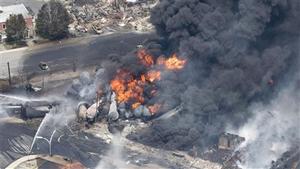HazmatPetroleum industry, railroads want deadline extension for phasing out old tank cars
Transportation of crude oil by train jumped to 408,000 in 2013, from 11,000 in 2009, partly due to the rise in production from North Dakota’s Bakken region, where oil production has surpassed pipeline capacity. The increasing use of rail to transport crude oil has resulted in several accidents. The Department of Transportation want to phase out older tank cars — because they have thinner shells and are thus more vulnerable to accidents when transporting flammable liquids like crude oil – and replace them with new, safer tank cars with thicker shells. The petroleum industry and U.S. railroads want DOT to extend the deadline for phasing out old tankers from two years to four years.

Old tank cars more vulnerable to disaster // Source: onaeg.com
Representatives from the American Petroleum Institute (API) and the Association of American Railroads (AAR) have suggested keeping older tank cars in service for twice as long as proposed by regulators from the Department of Transportation (DOT), which says that older tank cars are vulnerable to accidents when they transport flammable liquids like crude oil.
The move to phase-out older tank cars within two years, known as DOT-111s, is “not feasible,” said Jack Gerard, executive director of API, which represents Exxon Mobil Corp. and Chevron Corp., along with other petroleum industry firms. The proposal “could stifle North America’s energy renaissance and curtail substantial volumes of U.S. and Canadian oil production,” Gerard said.
API, citing a study by ICF International Inc., said the DOT proposed phase-out of older tank cars could limit the production and transportation of goods, costing consumers $45.2 billion. “In fact, PHMSA’s [DOT Pipeline and Hazardous Materials Safety Administration] timeline could harm consumers by disrupting the production and transportation of goods that play major roles in our economy, including chemicals, gasoline, crude oil and ethanol,” Gerard said.
The Insurance Journal reports that transportation of crude oil by train jumped to 408,000 in 2013, from 11,000 in 2009, partly due to the rise in production from North Dakota’s Bakken region, where oil production has surpassed pipeline capacity. The increasing use of rail to transport crude oil has resulted in several accidents, including one in 2013 when an unattended train carrying more than seventy oil tank cars rolled into Lac-Megantic, Quebec, derailing and exploding, killing forty-seven people. There have been five oil train accidents so far this year, while no accidents involving crude oil rail transportation were reported in 2010.
DOT chief Anthony Foxx called the proposed rules “the most significant progress” to date on crude oil transportation safety. “More crude oil is being shipped by rail than ever before. If America is going to be a world leader in producing energy, our job at this department is to ensure that we’re also a world leader in safely transporting it,” he said earlier in July.
Regulators with the Pipeline and Hazardous Materials Safety Administration (PHMSA) and the Federal Railroad Administration, both components of DOT, want older tank cars to be modified or eliminated within two years, when the new law goes into effect, but oil and railroad companies are asking for a two year extension to the proposed law. API and AAR, on behalf of manufacturers of tank cars, want new tank cars to have half-inch shells — slightly thicker than the latest models, but one-eighth of an inch thinner than options proposed by regulators.
The Greenbrier Companies of Lake Oswego, Oregon, a tank car maker, believes the DOT proposal offers enough time for tank car makers to adjust to the new requirements. Without an aggressive timeline, “we won’t move as quickly toward those safer standards as we otherwise might,” said spokesman Jack Isselman.
